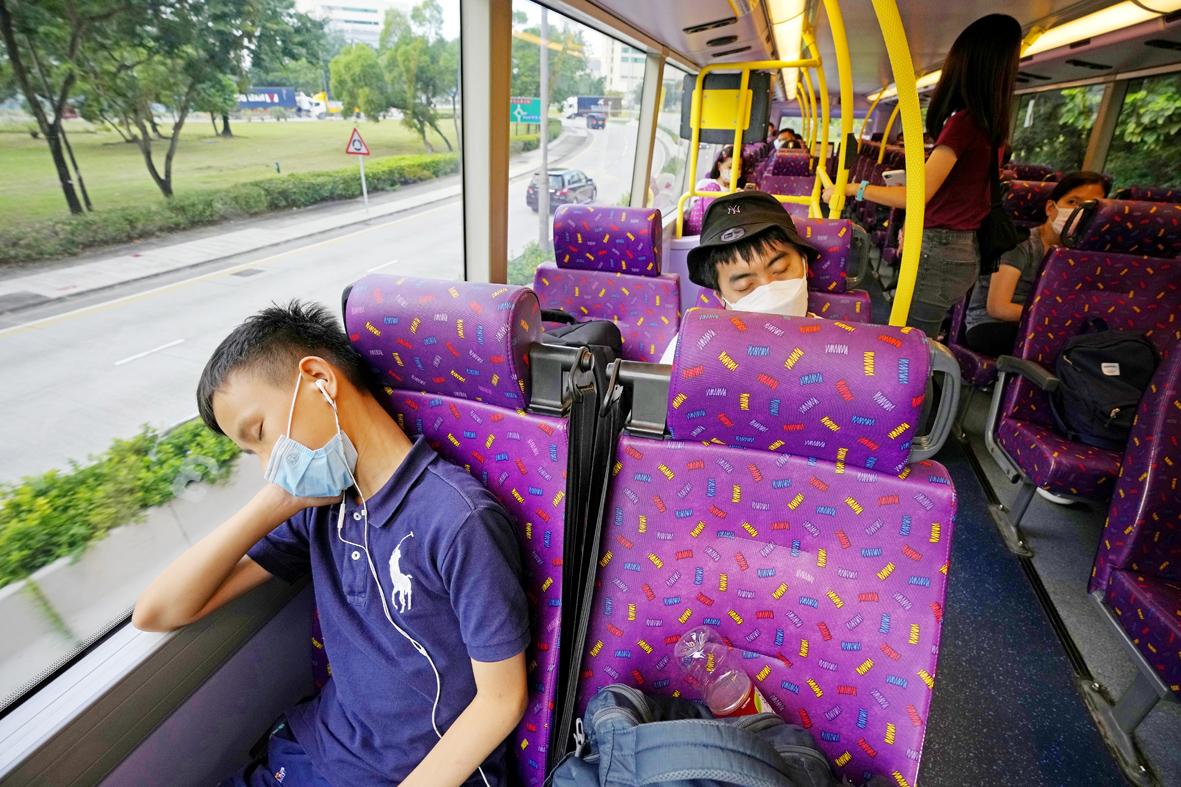Travel-starved, sleep-deprived residents might find a new Hong Kong bus tour to be a snooze.
The 76-kilometer, five-hour ride on a regular double-decker bus around the territory is meant to appeal to people who are easily lulled asleep by long rides. It was inspired by the tendency of tired commuters to fall asleep on public transit.
“When we were brainstorming new tours, I saw a social media post from my friend saying that he was stressed out by his work, he couldn’t sleep at night,” said Kenneth Kong, the marketing and business development manager of ulu travel, the organizer of the bus tours.

Photo: AP
“But when he was traveling on the bus, he was able to sleep well. His post inspired us to create this tour that lets passengers just sleep on the bus.”
Tickets cost between US$13 to US$51 per person, depending on whether they choose seats on the upper or lower deck. A goodie bag for passengers includes an eye-mask and ear plugs for better sleep.
The first “Sleeping Bus Tour” last Saturday sold out entirely. Some passengers came prepared, bringing their own blankets and changing their shoes to slippers, while others brought travel pillows.
“I have been suffering from insomnia so I am here to try and get some sleep,” said 25-year-old Anson Kong, one of the passengers on the first bus tour. He said that the tour was a good idea and “more interesting” than he expected.
On last Saturday’s tour, the bus stopped so passengers could take photos at scenic spots on the city’s Lantau Island. One stop was the aircraft maintenance area near Hong Kong’s airport, where passengers can snag selfies with aircraft in the background.
Another passenger, Marco Yung, said that he joined the tour because he usually falls asleep on long-distance bus journeys, saying it was a “great opportunity” to get some sleep.
The tendency to fall sleep on public transport is a type of conditioning, according to Dr. Shirley Li, the principal investigator of the Sleep Research Clinic and Laboratory at the University of Hong Kong.
“People in Hong Kong don’t have enough time to sleep,” Li said. “That’s why we have to kind of use other times to sleep, which is our daily commute, especially when we are travelling on public transport.” “For some people, they may tend to associate public transport with their sleep. And that’s why they found it easier to fall asleep on the bus,” she said.”

May 26 to June 1 When the Qing Dynasty first took control over many parts of Taiwan in 1684, it roughly continued the Kingdom of Tungning’s administrative borders (see below), setting up one prefecture and three counties. The actual area of control covered today’s Chiayi, Tainan and Kaohsiung. The administrative center was in Taiwan Prefecture, in today’s Tainan. But as Han settlement expanded and due to rebellions and other international incidents, the administrative units became more complex. By the time Taiwan became a province of the Qing in 1887, there were three prefectures, eleven counties, three subprefectures and one directly-administered prefecture, with

It’s an enormous dome of colorful glass, something between the Sistine Chapel and a Marc Chagall fresco. And yet, it’s just a subway station. Formosa Boulevard is the heart of Kaohsiung’s mass transit system. In metro terms, it’s modest: the only transfer station in a network with just two lines. But it’s a landmark nonetheless: a civic space that serves as much more than a point of transit. On a hot Sunday, the corridors and vast halls are filled with a market selling everything from second-hand clothes to toys and house decorations. It’s just one of the many events the station hosts,

Among Thailand’s Chinese Nationalist Party (KMT) villages, a certain rivalry exists between Arunothai, the largest of these villages, and Mae Salong, which is currently the most prosperous. Historically, the rivalry stems from a split in KMT military factions in the early 1960s, which divided command and opium territories after Chiang Kai-shek (蔣介石) cut off open support in 1961 due to international pressure (see part two, “The KMT opium lords of the Golden Triangle,” on May 20). But today this rivalry manifests as a different kind of split, with Arunothai leading a pro-China faction and Mae Salong staunchly aligned to Taiwan.

Two moves show Taichung Mayor Lu Shiow-yen (盧秀燕) is gunning for Chinese Nationalist Party (KMT) party chair and the 2028 presidential election. Technically, these are not yet “officially” official, but by the rules of Taiwan politics, she is now on the dance floor. Earlier this month Lu confirmed in an interview in Japan’s Nikkei that she was considering running for KMT chair. This is not new news, but according to reports from her camp she previously was still considering the case for and against running. By choosing a respected, international news outlet, she declared it to the world. While the outside world